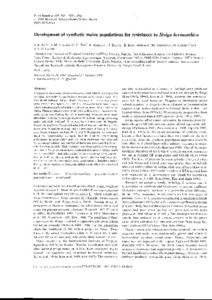| dc.contributor.author | Kim, S.K. |
| dc.contributor.author | Fajemisin, J. |
| dc.contributor.author | Thé, C. |
| dc.contributor.author | Adepoju, A. |
| dc.contributor.author | Kling, J. |
| dc.contributor.author | Badu-Apraku, B. |
| dc.contributor.author | Versteeg, M. |
| dc.contributor.author | Carsky, R. |
| dc.contributor.author | Lagoke, S.T.O. |
| dc.date.accessioned | 2019-12-04T11:23:37Z |
| dc.date.available | 2019-12-04T11:23:37Z |
| dc.date.issued | 1998 |
| dc.identifier.citation | Kim, S.K., Fajemisin, J., Thé, C., Adepoju, A., Kling, J., Badu‐Apraku, B., ... & Lagoke, S. (1998). Development of synthetic maize populations for resistance to Striga hermonthica. Plant Breeding, 117(3), 203-209. |
| dc.identifier.issn | 0179-9541 |
| dc.identifier.uri | https://hdl.handle.net/20.500.12478/4073 |
| dc.description.abstract | The parasitic witchweed, Striga hermonthica (Del.) Benth, is the greatest biological constraint for cereal crop production by resource-poor farmers in sub-Saharan Africa. Maize, Zea mays L., is a widely grown cereal crop in this region (22 × 106 ha). Striga-resistant maize populations were produced and tested as half-sib families in West and Central Africa. Three populations with white (W), yellow (Y), or mixed (Y/W) grain colour were formed by: (1) intercrossing Striga resistant maize inbred lines followed by two generations of random mating; (2) testing far under artificially induced S. hermonthica infestations in Nigeria, Cameroon, and Ivory Coast and selection of resistant families; (3) two generations of random mating; and (4) two years of testing for resistance. Striga-resistant synthetic W, Y and Y/W populations were produced by compositing resistant half-sib families. Outstanding performance in grain yields and host plant resistance was observed. Maize damage ratings and number of harvested ears were highly correlated with grain yield. High variation was observed for Striga emergence counts. The populations have combined resistance to Striga, maize streak virus (MSV), and other major biotic constraints for maize cultivation in Africa, thus providing the opportunity for improved sustainable maize production under stress environments. Breeder's seed of these synthetic varieties are being multiplied for distribution to national programmes. |
| dc.language.iso | en |
| dc.subject | Zea Mays |
| dc.subject | Striga Hermonthica |
| dc.subject | Parasitic Weed |
| dc.subject | Pest Resistance |
| dc.subject | Witchweed |
| dc.title | Development of synthetic maize populations for resistance to Striga hermonthica |
| dc.type | Journal Article |
| dc.description.version | Peer Review |
| cg.contributor.crp | Maize |
| cg.contributor.affiliation | International Institute of Tropical Agriculture |
| cg.contributor.affiliation | Institut de Recherche Agronomique, Cameroon |
| cg.contributor.affiliation | Ahmadu Bello University |
| cg.contributor.affiliation | Kyungpook National University |
| cg.coverage.region | Africa |
| cg.coverage.region | West Africa |
| cg.coverage.region | Central Africa |
| cg.coverage.country | Nigeria |
| cg.coverage.country | Cameroon |
| cg.isijournal | ISI Journal |
| cg.authorship.types | CGIAR and developing country institute |
| cg.iitasubject | Maize |
| cg.iitasubject | Weeds |
| cg.iitasubject | Pests Of Plants |
| cg.iitasubject | Plant Breeding |
| cg.accessibilitystatus | Limited Access |
| local.dspaceid | 99359 |
| cg.identifier.doi | https://doi.org/10.1111/j.1439-0523.1998.tb01927.x |

